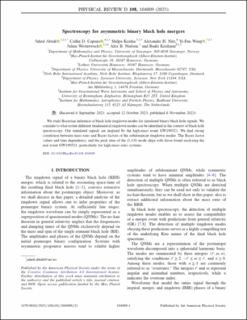| dc.contributor.author | Abedi, Jahed | |
| dc.contributor.author | Capano, Collin D. | |
| dc.contributor.author | Kastha, Shilpa | |
| dc.contributor.author | Nitz, Alexander H. | |
| dc.contributor.author | Wang, Yi-Fan | |
| dc.contributor.author | Westerweck, Julian | |
| dc.contributor.author | Nielsen, Alex Bentley | |
| dc.contributor.author | Krishnan, Badri | |
| dc.date.accessioned | 2024-03-14T09:46:24Z | |
| dc.date.available | 2024-03-14T09:46:24Z | |
| dc.date.created | 2023-12-01T14:05:24Z | |
| dc.date.issued | 2023 | |
| dc.identifier.citation | Abedi, J., Capano, C. D., Kastha, S., Nitz, A. H., Wang, Y. F., Westerweck, J., ... & Krishnan, B. (2023). Spectroscopy for asymmetric binary black hole mergers. Physical Review D, 108(10), 104009. | en_US |
| dc.identifier.issn | 2470-0010 | |
| dc.identifier.uri | https://hdl.handle.net/11250/3122340 | |
| dc.description.abstract | Black hole spectroscopy is the proposal to observe multiple quasinormal modes in the ringdown of a binary black hole merger. In addition to the fundamental quadrupolar mode, overtones and higher harmonics may be present and detectable in the gravitational wave signal, allowing for tests of the no-hair theorem. We analyze in detail the strengths and weaknesses of the standard Rayleigh criterion supplied with a Fisher matrix error estimation, and we find that the criterion is useful, but too restrictive. Therefore, we motivate the use of a conservative high Bayes factor threshold to obtain the black hole spectroscopy horizons of current and future detectors; i.e., the distance (averaged in sky location and binary inclination) up to which one or more additional modes can be detected and confidently distinguished from each other. We set up all of our searches for additional modes starting at t = 10(M-1 + M-2) after the peak amplitude in simulated signals of circular nonspinning binaries. An agnostic multimode analysis allows us to rank the subdominant modes: for nearly equal mass binaries, we find (l, m, n) = (2, 2, 1) and (3,3,0) and, for very asymmetric binaries, (3,3,0) and (4,4,0), for the secondary and tertiary modes, respectively. At the current estimated rates for heavy stellar mass binary black hole mergers, with primary masses between 45 and 100 solar masses, we expect an event rate of mergers within our conservative estimate for the (2,2,1) spectroscopy horizon of 0.03-0.10 yr(-1) for LIGO at design sensitivity and (0.6 - 2.4) x 10(3 )yr(-1) for the future third generation ground-based detector Cosmic Explorer. | en_US |
| dc.language.iso | eng | en_US |
| dc.publisher | American Physical Society | en_US |
| dc.rights | Navngivelse 4.0 Internasjonal | * |
| dc.rights.uri | http://creativecommons.org/licenses/by/4.0/deed.no | * |
| dc.title | Spectroscopy for asymmetric binary black hole mergers | en_US |
| dc.type | Peer reviewed | en_US |
| dc.type | Journal article | en_US |
| dc.description.version | publishedVersion | en_US |
| dc.rights.holder | The authors | en_US |
| dc.subject.nsi | VDP::Matematikk og Naturvitenskap: 400::Fysikk: 430::Astrofysikk, astronomi: 438 | en_US |
| dc.source.pagenumber | 12 | en_US |
| dc.source.volume | 108 | en_US |
| dc.source.journal | Physical Review D | en_US |
| dc.source.issue | 10 | en_US |
| dc.identifier.doi | 10.1103/PhysRevD.108.104009 | |
| dc.identifier.cristin | 2207460 | |
| cristin.ispublished | true | |
| cristin.fulltext | original | |
| cristin.qualitycode | 1 | |

